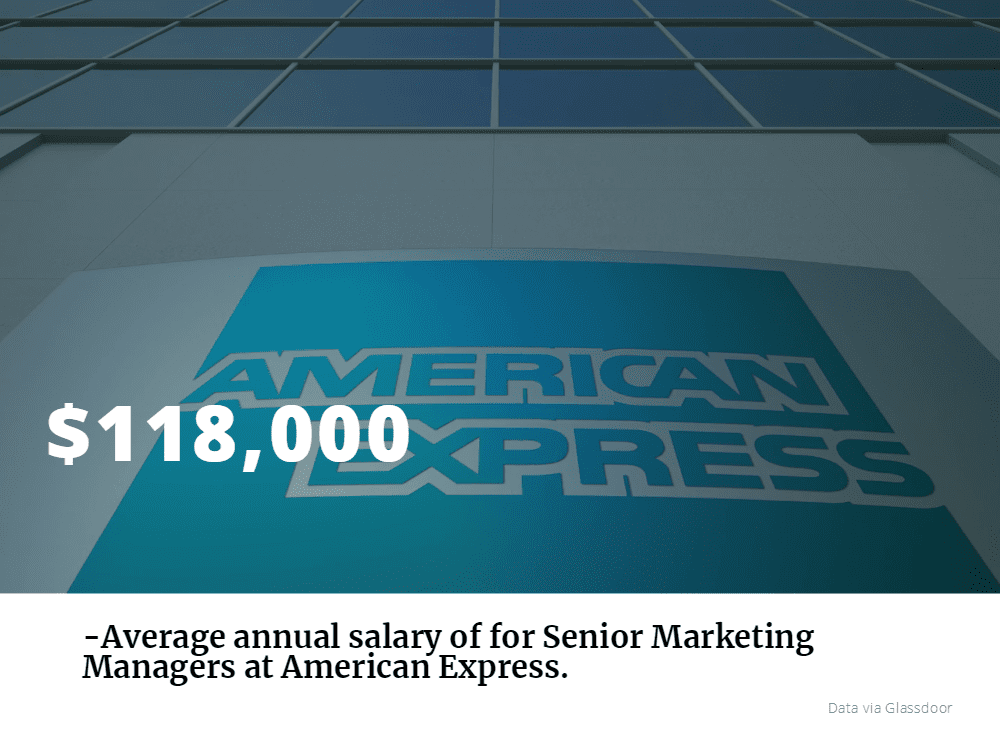Top MBA Recruiters: American Express

The fact that “Don’t leave home without it,” once American Express’ omnipresent tagline, is now “Don’t live life without it” speaks to its transformation. Its YouTube channel features content ranging from “Unlock the Money,” showing the evolution of various startups, to “Epic Everyday,” which offers crafty lifehacks like how to make smoothie ice cubes. Not just a credit company anymore, AMEX has billed itself an “engine of commerce.”
Like many global financial services groups in 2019, AMEX has learned that to thrive, it must adapt to meet the many needs of the millennial consumer. This, along with its wide variety of job opportunities and a top global recruitment program, make it a great place to work for MBAs.
Why American Express?
With over 65,000 employees worldwide, American Express was ranked 13th by Fortune on its “100 Best Companies to Work For” list in 2019. One of its major attractions is the recent added focus on work life balance, and it now offers a whopping five months of family leave time for new parents. Other benefits include generous healthcare coverage which begins on day 1 of employment, wellness and prevention programs, and tuition assistance. American Express also offers a variety of virtual positions, along with a compressed work week.
The company also matches employee donations to nonprofits, offers a variety of volunteer opportunities, and prioritizes environmental sustainability efforts across all levels of employment. It has also earned 100 percent on the Human Rights Campaign’s Corporate Equality Index for LGBTQ—inclusive workplace policies and practices. In addition, AMEX was voted the “Best Company for Diversity” by Black Enterprise in 2017 and one of the “Top Companies for Women in Tech” in the same year.
Phoenix, Salt Lake City, and Fort Lauderdale are listed as key cities for external hiring and internships, and the New York City headquarters is a top hiring location as well.
American Express Salaries
Glassdoor reports the typical American Express Analyst salary at $72,034. Managers make $101,000, while Senior Marketing Managers make $118,000. Top salaries are $149,000 for Marketing Directors and $196,000 for Vice Presidents.

Starting an American Express Career
American Express’ recruitment program is robust, and it hires MBA interns across all disciplines. According to one recruiter, “The culture and people at AMEX are what make it a great place to intern … [it’s] an environment centered around collaboration.” Interns can find opportunities in the following areas:
- Consulting
- Finance
- Marketing
- Operations
- Human Resources
- Risk and Governance
One former intern says, “Many of the casual coffee chats of my intern days have developed into true mentor-mentee relationships in my full-time career.” The 12 week summer internship program is offered in New York, Phoenix, or Fort Lauderdale, and AMEX also offers ‘talent communities’ in which students and professionals can track available opportunities and find matches for their abilities. Having shifted in the past decade to a focus on digital commerce, AMEX seeks MBA graduates who are well versed in data analysis, no matter what position they seek.
Top recruiting schools for AMEX include the New York University Stern School of Business, Columbia Business School, the University of Michigan Stephen M. Ross School of Business, Cornell’s SC Johnson School of Management, London Business School, IESE Business school in Barcelona, IIT Bombay, and IIM Ahmedabad. Roughly 250 interns and full-time hires are brought into the company each year, according to recent figures.
A final helpful piece of American Express career advice offered by a recruiter:
“It’s your job to sell us on your passion. I also need to understand that you know what the job is. That might seem obvious, but a lot of people come in unprepared. I love questions from candidates that look to the future: ‘What do my first 90 days look like?’ ‘What are the key things you’d like to help me to achieve?'”
MIT on the Problems with Twitter, and More – Boston News

Let’s explore some of the most interesting stories that have emerged from Boston business schools this week.
Marketers Take Note: When Too Many Choices are a Burden, Not a Benefit – Questrom School of Business News
BU Questrom School of Business Ph.D. alum Sarah Whitley recently co-authored a new Journal of Consumer Research paper with Associate Professor Remi Turdel and fellow Assistant Professor Didem Kurt, in which they discovered “that people typically want more choices when they’re buying for pleasure [and they want] fewer choices when they make a purchase for strictly utilitarian or functional reasons.”
The research dives into what is more commonly known as the Paradox of Choice. The idea crept into the market lexicon shortly after the release of the 2004 book The Paradox of Choice – Why More Is Less from psychologist Barry Schwartz, NYU alum and U. Penn Ph.D. The general idea Schwartz derived was that consumer anxiety could be caused by too many options. However, research from Whitley, Turdel, and Kurt reveal that it may only pertain to specific kinds of purchases, not simply overall.
Whitley says the major takeaway is that businesses can be more strategic if they know “what motivates the buying decisions of their customers.”
“For product categories where people feel that they have unique preferences, it may be worth it to have more variety. It may be fine to reduce the number of offered products where this is not the case.”
You can read the full article here.
Solving Twitter’s ‘Follow-Back’ Problem – MIT Sloan Newsroom
About four years ago, MIT Sloan Associate Professor of Operations Tauhid Zaman put together a social media experiment in which he used Taylor Swift’s friends on Twitter to “open the gates to her inner circle.”

Dubbed the “follow-back problem,” Zaman sought to understand “the underlying dynamics of follows on Twitter, [such as] what kinds of Twitter interactions matter the most when trying to get followers? And do overlapping social networks actually help build connections? If they do, then to what degree do they help?”
Zaman found that Twitters “who don’t follow many other people are unlikely to follow you back, while those who follow a lot of people are likely to follow you if you follow and retweet them.” He also found that if, for instance, “Swift follows somebody who, in turn, follows Zaman, then Zaman has a greater chance that Swift will follow him.”
The article notes that social media tools can “have a tremendous blast radius” in terms of their ability to powerfully influence the opinions of a whole country.
“In my opinion, this can be far more dangerous than conventional weapons which have a fixed blast radius. These are weapons, and I’m building efficient ways to use the weapons, so this has to be handled with care,” Zaman said.
Read the full article, the first in a three-part series examining new work about Twitter, influence, and bots, here.
How CEOs Manage Time – Harvard Business Review
Harvard Business School Professors Michael E. Porter and Nitin Nohria recently published a piece in the Harvard Business Review that examines how CEOs allocate their time.
According to the article, face-to-face interactions take up “61 percent of the work time of the CEOs we studied. Another 15 percent was spent on the phone or reading and replying to written correspondence. The final 24 percent was spent on electronic communications.”
The authors describe the CEO’s job as “relentless.” They write, “Given that work could consume every hour of their lives, CEOs have to set limits so that they can preserve their health and their relationships with family and friends. To sustain the intensity of the job, CEOs need to train—just as elite athletes do. That means allocating time for health, fitness, and rest.”
You can read the full article here.
Why More Male Celebs are Advertising Diet Products, According to This Wharton Prof

Americus Reed, marketing professor at University of Pennsylvania’s Wharton School, recently contributed his insight to an article in USA Today that explored diet firms’ trend toward utilizing male celebrity endorsements to promote their plans and products.
Male celebrities like ’80s wunderkind Rob Lowe (Atkins Nutritionals) and hip-hop producer DJ Khaled (Weight Watchers) have become the new male faces of these diets. Diet companies are shifting their advertising approach in order to draw in a male demographic and expand the reach of their products.
Women like Oprah Winfrey, Kirstie Alley, and Jennifer Hudson have been endorsing diet plans for decades, but the move toward male celebrity spokespeople is newer in the industry.
It makes sense that USA Today capitalized on Reed’s knowledge of consumers, as on his website, he is credited as the only “identity theorist” in Wharton’s Marketing Department. His research specifically addresses the effects of consumers’ senses of self on their shopping habits.
According to Reed, using celebrities to advertise is effective because fame comes with a great deal of power.
“Celebrity endorsements tap into that,” Reed says. ‘”I want to be like Rob Lowe, Kim Kardashian, Zac Efron, Taylor Swift. They use product X. I want to use X.’ It’s that straightforward of a persuasion.”
In reference to the company’s new marketing strategy, Scott Parker, the chief marketing officer of Atkins Nutrtionals, said, “We identified as a primary target for growth what we call self-directed people who are interested in eating better. The self-directed target is pretty evenly split between men and women … Clearly, needing to lose weight and lead a healthier lifestyle isn’t restricted to females.” Parker also indicated that Rob Lowe as a spokesperson appeals to both male and female demographics.
USA Today is not the first publication to benefit from Reed’s expertise. The New York Times and CBS Philly have quoted him in articles as well.
